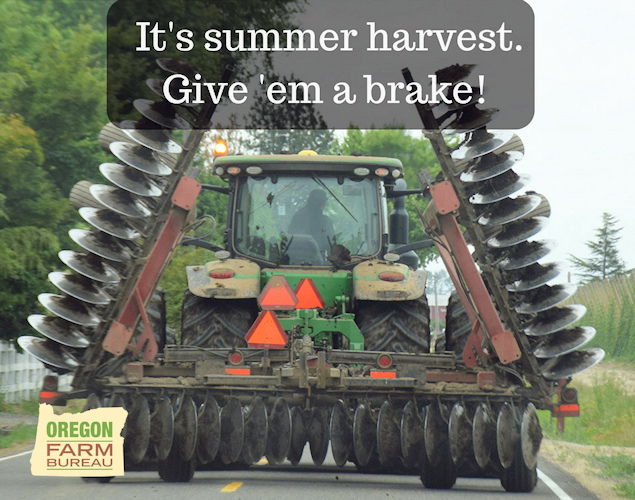Oregon Farm Bureau offers info on safely sharing road with slow-moving farm equipment

SALEM, Ore. (KTVZ) -- For many Oregon farmers who are #StillFarming, July 4 signifies the busiest time of year. Harvest of major crops like grass seed, berries, tree fruits, clover, and wheat is in full swing, and it’s not unusual for a farmer to spend 15-hour days working in the field.
Summer harvest also means that sometimes farmers must drive their large equipment, such as tractors, swathers, combines and trucks, out onto public roads to move between fields. Farmers do their best to avoid moving equipment during high-traffic times, but during peak harvest, when the fruit is ripe or the hay is at the optimum level of dryness, they often have no choice.
“While driving a slow-moving tractor on a highway is legal and often a necessary part of harvest, it can pose a safety risk without caution, courtesy, and patience,” said Kristie Glaser, vice chair of the OFB Health & Safety Committee. “We’re reminding drivers to slow down, be patient, and use caution when encountering a tractor on the road.”
To help drivers share the road safely with farm equipment, the Oregon Farm Bureau Health & Safety Committee offers a one-minute video and a free brochure with important tips for both motorists and farmers.
- Watch the video on OFB’s website
- Watch the video on OFB’s Facebook
- Watch the video on OFB’s YouTube channel
- Watch the video on OFB’s Instagram
- Watch the video and download a brochure with information for both motorists and farmers about rural road safety at https://OregonFB.org/safety
According to the Oregon Department of Transportation (ODOT), in 2017 there were a total of 42 crashes statewide involving farm equipment, resulting in one fatality and 32 non-fatal injuries. This is a significant increase from 2013 when there was a total of 26 crashes involving farm equipment, with no fatalities and 11 non-fatal injuries.
“It’s heartbreaking to hear about injuries or deaths involving tractors that could’ve been avoided if drivers had simply slowed down, or farmers had taken a few simple steps,” said Glaser.
And as driving apps become the norm, more motorists than ever before are using rural roads for everyday travel.
“Our rural roads are no longer being used just for getting agricultural products to market. They’re now being used as back-road commuting highways,” said Glaser. “Too many people underestimate how dangerous it is when you don’t slow down or try to pass a tractor recklessly, or even illegally over a double line or on a curve.”
Most farm equipment is designed to travel at speeds of no more than 25 miles per hour (mph), and must display a reflective, triangular, orange-and-red, slow-moving-vehicle sign if going out on public roads.
It can be surprising just how slow 25 mph is on the highway. A tractor that looks far on the horizon can be directly in front of a fast-moving car within seconds.
“If you’re driving 55 mph on a highway and come upon a tractor that’s moving at 25 mph, it can take only 8 seconds to close a gap the length of a football field. You’ll be right behind that heavy piece of equipment very quickly,” said Glaser.
Safety tips for drivers include:
• If you decide to pass farm equipment on the road, please do so with caution.
• Be watchful of vehicles behind you that may also try to pass.
• If you must enter the oncoming lane of traffic, do not proceed unless you can see clearly ahead of both your vehicle and the vehicle you will pass.
• If there are any curves or hills ahead that may block your view or the view of oncoming vehicles, do not pass.
• Do not pass if you are in a designated “No Passing Zone” or within 100 feet of any intersection, railroad grade crossing, bridge, elevation structure, or tunnel.
• Do not assume that a farm vehicle that pulls to the right side of the road is going to turn right or is letting you pass. Due to the size of some farm implements, the farmer must make wide left-hand turns. If you are unsure, check the operator’s hand signals and look at the left side of the road for gates, driveways, or a place the vehicle might turn.
Safety tips for farmers include:
• Oregon law requires a slow-moving vehicle reflector on any machine that travels the road slower than 25 mph. Always point the triangle up, keep the SMV emblem clean to maximize reflectivity, and replace the emblem when it fades, normally every two to three years.
• Mark the edges of tractors and machines with reflective tape and reflectors. Consider installing retrofit lighting to increase visibility.
• Turn on your lights, but turn off rear spotlights when going onto the road. From a distance, spotlights can be mistaken for headlights.
• Be aware of heavy traffic patterns.
• Consider installing mirrors on equipment so you can see motorists around you. Be careful where the mirrors are placed.
• When moving multiple farm implements down the highway, leave enough space between each vehicle for cars to pass.
Request a copy of the printed OFB Rural Road Safety Brochure by calling 503.399.1701 or emailing a request to annemarie@oregonfb.org.
###
Oregon Farm Bureau (OFB) is a grassroots, nonpartisan, nonprofit, general farm organization representing the interests of farming and ranching families in the public and policy-making arenas. First established in Oregon at the county level in 1919 and the state level in 1932, Farm Bureau is organized in all 36 counties.
Oregon Farm Bureau President Barb Iverson comes from a multigenerational family farm from Woodburn, raising industrial hemp, grass seed, squash, vetch seed, hazelnuts, wine and table grapes, and operating the Wooden Shoe Tulip Festival, which attracts over 160,000 visitors each year. Iverson is OFB’s 17th president.